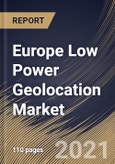The Europe Low Power Geolocation Market is expected to witness market growth of 24.5% CAGR during the forecast period (2021-2027).
IP-based geolocation is more precise for almost all applications and purposes. There are a huge number of IP-based location datasets around the world. On the other hand, Bluetooth-based low power geolocation for indoor location plays a crucial part since it provides energy-efficient, low-cost, and easy-to-implement indoor positioning solutions.
In addition, advancements in digital or smart infrastructure across retail malls, airports, and other sectors, are leading to the high requirement for enhancing fleet management solutions, which is anticipated to fuel the growth of the low power geolocation market over the forecast period.
European Union (EU) General Data Protection Regulation (GDPR) is one of the crucial laws enforced in the region to protect data extracted by low power geolocation technology. Location data in the EU can be used as per the GDPR’s widely applicable requirements of fairness, lawfulness, transparency, data minimization, purpose limitation, accuracy, integrity & confidentiality, storage limitation, and accountability.
However, any kind of unauthorized location access is subjected to legal actions. Thus, it is highly crucial for companies to extract location data within the legal framework and also protect this data from any misleading activities.
The Germany market dominated the Europe Low Power Geolocation Market by Country 2020, and is expected to continue to be a dominant market till 2027; thereby, achieving a market value of $6.41 billion by 2027. The UK market is poised to grow at a CAGR of 23.6% during (2021 - 2027). Additionally, The France market is expected to showcase a CAGR of 25.4% during (2021 - 2027).
Based on Geolocation Area, the market is segmented into Indoor and Outdoor. Based on Technology, the market is segmented into LPWAN, GPS, UWB, Wi-Fi, Bluetooth and Others. Based on Solutions, the market is segmented into Hardware, Software and Service. Based on End User, the market is segmented into Logistics & Transportation, Healthcare, Consumer Electronics, Agriculture, Power Utilities and Others. Based on countries, the market is segmented into Germany, UK, France, Russia, Spain, Italy, and Rest of Europe.
The market research report covers the analysis of key stake holders of the market. Key companies profiled in the report include Digital Matter, Favendo GmbH, Semtech Corporation, Cisco Systems, Inc., Hoopo Systems Ltd., STMicroelectronics N.V., Kerlink SA, Nestwave SAS, Sigfox S.A. (Citymesh), and Tracktio.
Scope of the Study
Market Segments Covered in the Report:
By Geolocation Area
- Indoor
- Outdoor
By Technology
- LPWAN
- GPS
- UWB
- Wi-Fi
- Bluetooth
- Others
By Solutions
- Hardware
- Software
- Service
By End User
- Logistics & Transportation
- Healthcare
- Consumer Electronics
- Agriculture
- Power Utilities
- Others
By Country
- Germany
- UK
- France
- Russia
- Spain
- Italy
- Rest of Europe
Key Market Players
List of Companies Profiled in the Report:
- Digital Matter
- Favendo GmbH
- Semtech Corporation
- Cisco Systems, Inc.
- Hoopo Systems Ltd.
- STMicroelectronics N.V.
- Kerlink SA
- Nestwave SAS
- Sigfox S.A. (Citymesh)
- Tracktio
Unique Offerings from the Publisher
- Exhaustive coverage
- The highest number of market tables and figures
- Subscription-based model available
- Guaranteed best price
- Assured post sales research support with 10% customization free
Table of Contents
Companies Mentioned
- Digital Matter
- Favendo GmbH
- Semtech Corporation
- Cisco Systems, Inc.
- Hoopo Systems Ltd.
- STMicroelectronics N.V.
- Kerlink SA
- Nestwave SAS
- Sigfox S.A. (Citymesh)
- Tracktio
Methodology

LOADING...








